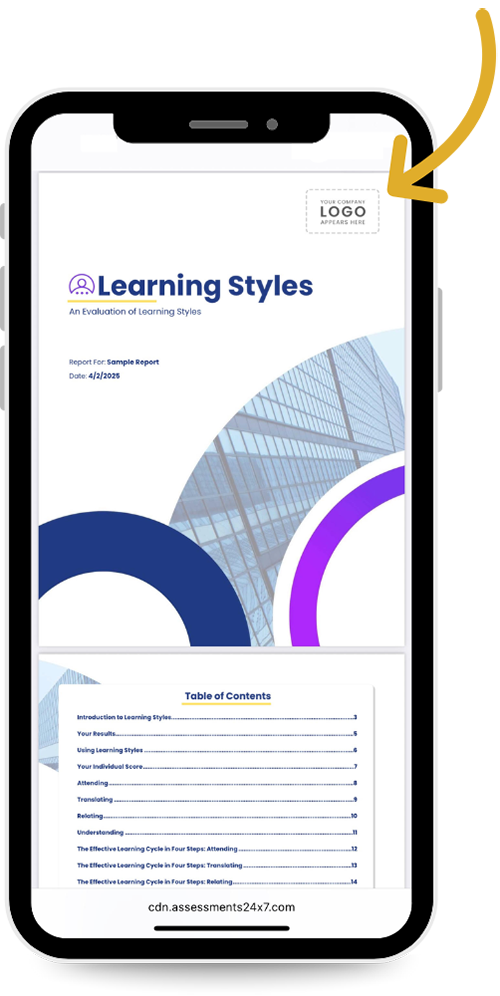Learning Styles Assessment
All learners are not equal. They come from a wide variety of cultural backgrounds, have many
different experiences, and use
different methods of learning. Some like
to learn from text, while others want visual support and images. Some assimilate
information individually while others prefer to work in groups. In
the end, the only thing that can be said with certainty is
that every
individual learns in their own way.

Measuring Learning Styles
The Learning Styles questionnaire was developed after extensive research into how people
prefer to learn. It aims to help each person understand their own learning style and
consider the learning styles of others as they share information and help others learn.
We are all teachers sometimes, and this model is used for both our individual learning
and facilitating learning with others. The self-scoring instrument uses 40 pairs of
questions to help you develop a personal learning styles profile and determine your own
best strategies for learning effectiveness.
The Learning Styles assessment reveals where our general preferences, or natural
learning biases, might lie. Although this is far from an exact science, the more we can
understand about how we receive, retain, and recall new information, the more
intentional we can be in setting ourselves up for success in learning transfer.
A unique blend of learning
This assessment measures and provides insight into our Learning Style preferences, made up of 4
steps in the Learning Cycle with sub-categories to further explain our unique blend of learning:
Attending: Motivation to learn. Our commitment and concentration
given to new information. (Telescopic and Wide-angled)
Relating: Linking data to existing knowledge. Evaluating our perception
of information and data. (Visual, Auditory, and Kinesthetic)
Translating: Making information meaningful. Who we rely on most to
manage our learning transfer. (Dependent, Collaborative, and
Autonomous)
Understanding: Using and applying the knowledge. How we synthesize
and use
the information we receive. (Global and Analytical)


Learning with the whole brain
While we may have different blends of learning preferences, we all do our best learning when we engage our whole brain. We inherently use different parts of our brain to learn different things, and activate different parts of our brains more readily than other parts as we learn. The important thing to remember is that all of our learning experiences should engage our whole brain to give us the best attention, retention, recall, and application.
White label our assessments with your own brand's logo
With our white-labeled option, you can do more than just use your branding! 25+ years of research and development is now yours to customize, market, and sell in a way that works for your business. You have the freedom to do it your way and charge what you need to for industry-leading technology, assessments, and resources, no matter the size of your organization. By partnering with Assessments 24x7, you are working with thousands of other consultants, trainers, coaches, and teams around the world to help grow their businesses.
For organizations large and small, developing effective hiring and selection practices, onboarding, and development programs are critical to promote the identity and culture of your business and ensure a strong, aligned workforce. Whether you are an HR professional, trainer, leader, or manager, using assessments helps you to hire smarter, grow sales in a way that creates strong retention in client relationships, resolve conflict before it starts, and offer your employees a world-class training curriculum to support their personal and professional growth. With tailored corporate solutions to fit your organization, whether you are a small start-up or a Fortune 500 company, Assessments 24x7 has what your business needs.

Quick to complete
With an average completion time of 12-15 minutes, every assessment questionnaire is delivered by email link, subsequently generating a PDF report that is automatically uploaded to the member’s white-labeled dashboard.
Available languages
Our internationally accredited Learning Styles assessment is currently available in multiple languages. See our sample reports page for the list of available languages and to view sample results.
Learning Styles with DISC
Through combination assessments, two valuable tools are offered in one report. DISC will
support understanding behavior, emotion, and communication style, and Learning Styles
reveals
how learning preferences affect the ability to take in new information, process and make it
meaningful, and store and retrieve it to apply when needed.
This combination of resources provides beneficial insight to help anyone become more
intentional with their communication and to advocate for their own learning, ensuring every
interaction and learning experience is effective and useful.

Frequently Asked Questions
Why is understanding Learning Styles important?
The goal with any assessment is to help create understanding and awareness so we can be more
intentional to get what we want out of life. With Learning Styles, we can become advocates of
our own learning experience, and learn about ways to share information with others in a way that
works! By understanding our own learning preferences and the preferences of others, we can
ensure we are setting up our learning experiences to support the most effective learning
transfer possible. For example, if I know that I am more of a wide-angled learner who will be
easily influenced by the environment as I learn, I can create the best situation for me by
removing potential distractions (sitting in the front of the room, wearing layered clothing to
be able to get warmer or cooler, having a bottle of water, etc.). By acknowledging my learning
needs and preparing for them, I can set myself up for learning success.
How and when should Learning Styles be used?
In an ideal situation, Learning Styles would be a foundational tool that comes before any other
assessment, training, or experience, because the information in Learning Styles can be
beneficial before we take on new information. For many of us, though, we've not had the
opportunity to start with Learning styles, so the sooner the better is a great rule! If you
don't yet know exactly what your learning preferences are, this is for you!
Learning Styles can be used in coaching, training, employee development, personal and
professional development, sales, service, and more, across any industry or organization, no
matter the size. Because the usefulness of learning styles extends beyond the self to
effectively facilitate learning with others, it can make a difference in any circumstances where
learning transfer occurs.
What is the difference in Learning Styles and the traditional VAK (VARK)
models?
Most people are familiar with the traditional Visual, Auditory, and Kinesthetic (VAK) learning
model. Recently, VAK has been modified to include an "R" for Reading and Writing, which have
been pulled out as separate learning modalities. Historically, reading and writing were included
as part of VAK (reading being both a visual and an auditory learning activity when read aloud,
and writing being both visual and kinesthetic).
It was once thought that each of us had a propensity to V, A, or K. Still, research shows that
though we may have a stronger preference for one or two of these methods, our best retention
comes by engaging all 3 - seeing it, hearing it, and physically interacting with the new
information to make connections in our whole brain!
The Learning Styles model used at Assessments 24x7 includes the VAK model in our Step 3 -
Relating, as part of the process of linking new data to existing data and helping us make sense
of the information we've received. VAK allows us to create relationships that we can use for
short- or long-term storage and recall.
